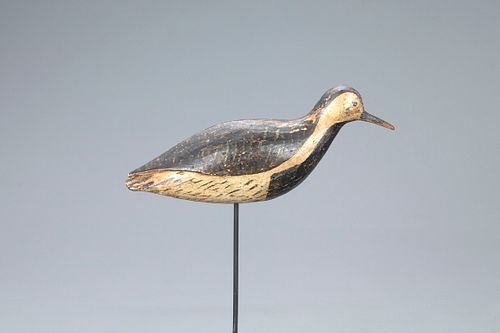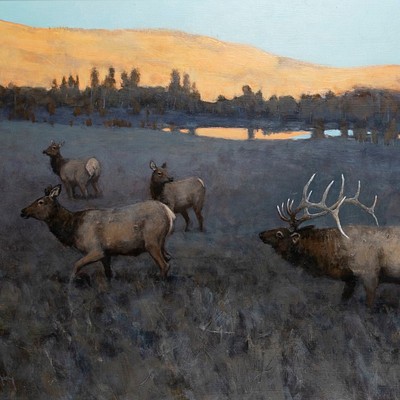Rare Running Plover Decoy
Lot 192
About Seller
Copley Fine Art Auctions
20 Winter Street
Pembroke, MA 02359
United States
Founded in 2005, Copley Fine Art Auctions is a boutique auction house specializing in antique decoys and American, sporting, and wildlife paintings. Over the course of the last two decades, the firm has set auction records for not only individual decoy makers, but also entire carving regions. Copley...Read more
Categories
Estimate:
$5,000 - $8,000
Absentee vs Live bid
Two ways to bid:
- Leave a max absentee bid and the platform will bid on your behalf up to your maximum bid during the live auction.
- Bid live during the auction and your bids will be submitted real-time to the auctioneer.
Bid Increments
| Price | Bid Increment |
|---|---|
| $0 | $50 |
| $1,000 | $100 |
| $2,500 | $250 |
| $5,000 | $500 |
| $10,000 | $1,000 |
| $25,000 | $2,500 |
| $50,000 | $5,000 |
About Auction
By Copley Fine Art Auctions
Jul 23, 2020
Set Reminder
2020-07-23 10:00:00
2020-07-23 10:00:00
America/New_York
Bidsquare
Bidsquare : The Sporting Sale 2020
https://www.bidsquare.com/auctions/copley/the-sporting-sale-2020-5244
Copley Fine Art Auctions The Sporting Sale 2020 Copley Fine Art Auctions cinnie@copleyart.com
Copley Fine Art Auctions The Sporting Sale 2020 Copley Fine Art Auctions cinnie@copleyart.com
- Lot Description
Rare Running Plover
Cobb Island, VA, c. 1870
11 in. long
Nathan Cobb Sr. sailed his family south from Cape Cod to the Eastern Shore of Virginia where they settled around 1837. The family brought with them Massachusetts carving concepts, including the refined split-tail carving style adopted by Lothrop Holmes, A. Elmer Crowell, and Joseph Lincoln. Over time, the Cobbs evolved this style into their own. A well-balanced decoy, this plover exhibits pleasing proportions with full cheeks and a plump body that resolves with a precise Cobb Island wing carving and tail cut. Birds from this important Cobb rig were first discovered by William J. Mackey Jr., from whose collection this decoy hails. Later, they were brought to the broader public’s attention when Henry A. Fleckenstein Jr. featured related examples in his "Shore Bird Decoys" book. This plover, with its crisp clean lines and original bill, hits the highest level of craftsmanship seen in the decoys that survived the remote island’s storm-wrecked history.
The underside bears both the "Mackey Collection" and “NELSON” collection stamps and an incised "J J."
In early gunning paint with minor darkening to spots of flaking.
Provenance: William J. Mackey Jr. Collection
Robert Gresham Collection
Grant Nelson Collection
Literature: Henry A. Fleckenstein Jr., "Shore Bird Decoys," Exton, PA, 1980, p. 130, back dust-jacket cover, related example illustrated.
Joe Engers, ed., "The Great Book of Wildfowl Decoys," San Diego, CA, 1990, pp. 166-167, related example illustrated.
Dr. Lloyd Newberry, "The Saga of Cobb Island," Sporting Classics, Spring/Summer 2018, pp. 140-145, related example illustrated.
Robert H. Richardson, ed., "Chesapeake Bay Decoys," Burtonsville, MD, 1991, p. 184, related decoy illustrated.Please email condition report requests to colin@copleyart.com. Any condition statement given is a courtesy to customers, Copley will not be held responsible for any errors or omissions. The absence of a condition statement does not imply that the lot is in perfect condition.Condition
- Shipping Info
-
Shipping info
Copley Fine Art Auctions does not handle the shipping of any items. Shipping is the sole responsibility of the buyer. Once your payment has cleared, and we have received your authorized shipping release form items may be released for shipment. Copley Fine Art Auctions, LLC shall have no liability for any loss or damage to such items. Buyers should allow up to four weeks for shipment.Please be aware that internet bidders may NOT not pick up their items at the sale. Items will be available for pick up by appointment or by shippers five days after the sale.
-



 EUR
EUR CAD
CAD AUD
AUD GBP
GBP MXN
MXN HKD
HKD CNY
CNY MYR
MYR SEK
SEK SGD
SGD CHF
CHF THB
THB














